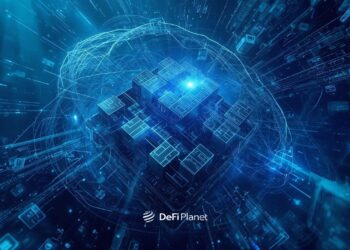Blockchain technology has proved to be a game-changer in the tech industry solely for its promise of a truly private and decentralized world. Another cutting-edge technology rocking the tech industry is Artificial Intelligence (AI). By simulating human problem-solving intelligence, AI enables effective multitasking, decreases human errors, and increases productivity, among other benefits.
Combining these two disruptive technologies enables humanity to create an efficient, decentralized, and autonomous economy that is radically better and different from what is currently possible. This is what Fetch.ai attempts to do.
The ultimate goal of the project is to create a decentralized ecosystem with high-level data sharing, management and storage that benefits every stakeholder in this futuristic economy. What this translates to in our modern paradigms is that the platform would handle billions of connected devices and provide secure, automatic, and seamless connectivity. Thus, it is an exciting prospect for the future of technology.
This article is both a guide and a comprehensive review of Fetch.ai. It covers everything from how Fetch.ai works to its potential for growth and adoption. Let’s get to it.
What is Fetch.ai?
Fetch.ai is a blockchain-based, open-access, decentralized machine-learning network that was developed to enable the expansion and evolution of the digital economy without human intervention. The network develops the tools and infrastructures to aid the growth of an AI-based, decentralized digital economy.

The network connects services, devices, and people, facilitating extensive collaboration and data sharing. Fetch.ai comprises suppliers and consumers, and its economy centres on various agents and ecosystems with a range of functions and use cases.
Toby Simpson, an artificial intelligence-trained computer scientist, and Humayun Sheikh, a successful technology entrepreneur with over 20 years of experience, collaborated with a team of experts in machine learning, blockchain, and decentralized systems to launch the project in 2017
How Fetch.ai Works
The Fetch.ai team created a layered architecture for the platform to address the need to create data-based value and ensure it gets to the right places. These three layers strongly echo the platform’s main goals; they are:
Autonomous Economic Agents (AEAs):
AEAs are economic programs (software/code) serving their owners while also possessing autonomy. Their purpose is to generate financial value for their owners. These agents can be configured to emulate real-world entities, facilitating interaction and transactions.
Each agent perceives a reality tailored to meet its specific requirements. The Fetch.ai platform strategically positions agents seeking value alongside those already possessing it.
Open Economics Framework (OEF):
OEF operates as a high-level abstraction node functionality built on top of the raw protocol and ledger. This layer creates an environment enabling economic agents to communicate and discover each other within a decentralized world. It plays a crucial role in facilitating seamless interactions among agents.

Smart Ledger:
The smart ledger manages reputation, trust, and intelligence to uphold the system’s integrity. Its role is pivotal to Fetch.ai’s value proposition as it deals with market intelligence that agents require for optimal functioning. It also includes using machine learning to identify market interactions and dynamics effectively.
The Fetch.ai blockchain was built on the Cosmos-SDK interchain protocol. This allows it to communicate with other blockchains within the Cosmos ecosystem via the inter-blockchain communication (IBC) protocol. It uses a customised Tendermint Proof of Stake as its consensus mechanism and Cosm-Wasm as its smart contract language.
Fetch.ai Token (FET) and Its Use Cases
FET is the platform’s native token, and it is designed to perform several roles in the protocol’s ecosystem. Users need to stake FET (via the Proof of Stake mechanism) to participate in securing the platform and also get incentives.

The following is a list of what FET is designed to do on the platform.
- Development and Access Provision to AI/ML Algorithms. FET aids the development of and access to various artificial intelligence and machine learning tasks. These tasks could be basic ones created by the Fetch.ai Network, such as trust and prediction models, or expansive ones created independently for network members.
- Value Exchange Between Agents. The FET token is necessary to enable value exchange between any two agents, irrespective of their location. Its divisibility allows for transactions that aren’t worth much money on their own but make a significant value when added together.
- Access Provision For Nodes and Agents. FET tokens are needed to get into, view, and interact with the platform’s decentralized digital world. This access token functions as a form of stake to show the participants’ intention to conduct themselves responsibly. Due to the increasing expense of doing so, it limits the capacity of malicious actors to flood the network with undesired nodes or agents.
Use Cases of Fetch.ai and Potential Future Applications
Fetch.ai has various use cases, and each can potentially revolutionize multiple industries. The project’s development team has shown how the network can transform areas such as the supply chain, smart homes, smart parking, transportation, energy, and collective learning. Some of the potential future applications of Fetch.ai include:
Healthcare
Fetch.ai can be used in the healthcare industry to create a secure and decentralized market for medical data. Medical data is commonly stored in centralized systems, which are vulnerable to hacking and other security flaws. Using blockchain technology and AI, Fetch.ai can provide a secure and decentralized platform for storing and exchanging medical data. This can improve the accuracy and efficiency of medical diagnosis and treatment while also giving individuals more control over their medical data.
Fetch.ai can also improve the effectiveness of healthcare services by automating administrative tasks, optimizing appointment scheduling and patient record management processes, and maintaining patient data. Fetch.ai’s AI algorithms, for example, can be used to review patient data and identify trends that might be leveraged to improve therapy outcomes.
Furthermore, Fetch.ai’s decentralized marketplace can connect patients and healthcare providers, making it easier for patients to find the best healthcare options and for providers to reach a larger audience.
Energy
Fetch.ai has several potential applications in the energy sector, including:
- Decentralized Energy Trading. Fetch.ai facilitates safe and transparent transactions based on supply and demand, allowing peer-to-peer energy trading between homes, businesses, and other entities. This could help to build a more effective and resilient energy market that rewards renewable energy providers and promotes energy efficiency.
- Smart Grid Optimization. Fetch.ai employs machine learning algorithms to forecast energy demand and supply, manage energy storage, and optimize energy flows in smart grids. This improves the efficiency of smart grids. This can help reduce energy expenditures, increase grid dependability, and reduce energy waste.
- Integration of Renewable Energy Sources. Fetch.ai can help integrate renewable energy sources, including solar and wind power, into the current energy system by providing real-time monitoring and control of energy production and delivery. This increases the share of renewable energy in the total energy mix while decreasing carbon emissions.
- Energy Efficiency Monitoring. Fetch.ai uses artificial intelligence to analyze patterns of energy usage, identify areas of waste, and suggest energy-saving solutions in order to monitor and enhance energy efficiency in buildings, factories, and other facilities. This can improve the overall sustainability of the energy system while cutting energy prices and carbon emissions.
Smart Cities
Fetch.ai can be used in different ways to improve the effectiveness and sustainability of urban systems. Here are a few examples:
- Autonomous Mobility. To optimize routes and ease traffic, a decentralized network of autonomous vehicles that can communicate with one another can be developed using Fetch.ai. This could lead to reduced pollution and more efficient transportation networks.
- Waste Management. Fetch.ai can be used to create a decentralized waste management system that optimizes garbage collection and recycling procedures.
- Air Quality Monitoring. Fetch.ai can be used to create a decentralized network of sensors that monitor air quality in different parts of the city. This information can be used to identify areas with high levels of air pollution and implement preventive measures.
- Emergency Response. In case of emergency, Fetch.ai can be used to create a decentralized emergency response system capable of responding quickly and effectively to crises such as natural disasters and accidents.
In Conclusion,
Fetch.ai represents a promising and innovative project that is harnessing the power of Artificial Intelligence, blockchain technology, and multi-agent systems to create an efficient and decentralized digital ecosystem.
Leading businesses across several industries, including Bosch and Datarella, have joined forces with Fetch.ai in different partnerships. Through these collaborations, Fetch.ai might increase the number of users using its platform and also offer more use cases.
Fetch.ai faces certain challenges and obstacles that impact its adoption and market penetration. One significant hurdle is the cost of educating the community about the platform’s potential. Being a pioneering project, Fetch.ai has to invest time and resources in raising awareness and enhancing understanding of its products and technology. Addressing this challenge is crucial for expanding awareness and driving widespread adoption of the protocol.
The potential for growth and success of Fetch.ai is vast, and as the project continues to evolve, we can expect to see exciting new use cases emerge that could transform the way we live and work. Fetch.ai is a project to watch closely in the coming years.
Disclaimer: This article is intended solely for informational purposes only and should not be considered trading or investment advice. Nothing herein should be construed as financial, legal, or tax advice. Trading or investing in cryptocurrencies carries a considerable risk of financial loss. Always conduct due diligence.
If you would like to read more articles like this, visit DeFi Planet and follow us on Twitter, LinkedIn, Facebook, and Instagram, and CoinMarketCap Community.
“Take control of your crypto portfolio with MARKETS PRO, DeFi Planet’s suite of analytics tools.”





















